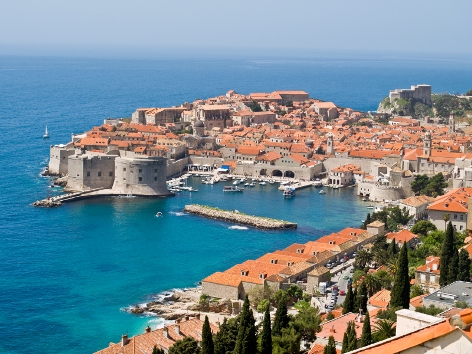

The Walls of Dubrovnik (in Croatian: Dubrovačke
gradske zidine) are a series of defensive stone walls that have
surrounded and protected the citizens of the, later proclaimed,
city-state maritime of Dubrovnik (the city was officially called
Ragusa until the year 1916), located in southern Dalmatia (currently
under the sovereignty of modern Croatia). With numerous additions
and modifications throughout its history, it has been considered one
of the great fortifications of the Middle Ages, since it was never
raped by a hostile army during this period of time. In 1979, the old
city of Dubrovnik, which includes a substantial portion of the
ancient walls of Dubrovnik, was declared a World Heritage Site by
Unesco.
The oldest systems of fortifications around Dubrovnik
were probably wooden palisades.Today the preserved city walls are
those built, mainly, between the 12th and 17th centuries, especially
a double line, which has For a long time it has been a source of
pride for Dubrovnik.The walls make an uninterrupted route of
approximately 1 940 meters in length, which surrounds most of the
ancient city, and reach a maximum height of about 25 meters. The
existing walls and fortifications were built during the 14th and
15th centuries, but have been extended and strengthened continuously
until the 17th century. This complex structure is among the largest
and most complete in Europe. It protects the freedom and security of
a "civilized" and "sophisticated" society that flourished in peace
and prosperity for five centuries. The walls of Dubrovnik were
reinforced by three circular towers and fourteen quadrangular, five
bastions, two large and Angular fortifications and the Fortress of
San John.
The walls were further reinforced by nine small,
semicircular bastions and Fort Bokar (Casemate), the oldest
preserved fortress of its kind in Europe.The moat that ran around an
outer section of the walls was armed with more than 120 cannons. ,
which made the defense of the city magnificent. City walls and
towers of Dubrovnik is considered some of the most well preserved
fortifications in Europe. Most of Dubrovnik City Walls were
constructed in the 16th century, although first defenses surrounded
the settlement in the 10th century. Current Dubrovnik Fortress was
erected under supervision of two Italian architects Michelozzo and
Antonio Ferramolino. They reach a total perimeter length of 1940
meters or 1.24 miles. Dubrovnik walls range from 4 to 6 months in
thickness. Thinner walls line the part of the city that lies on the
sea shore. Italian architects also added military fortifications
including the tower Minceta, Pile Gate, Fortress Bokar and also two
separate castles of Lovrijenac and Revelin. City walls were under
protection of Saint John. Protective breakwater of the Dubrovnik
Harbor was added in 1484. It defended the city from sea pirates and
storms.